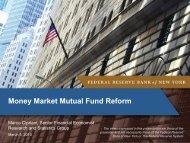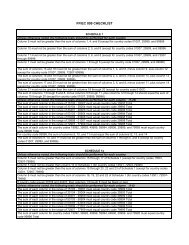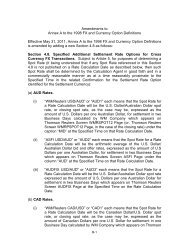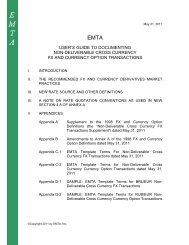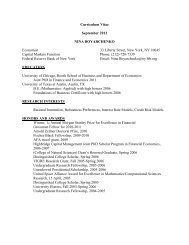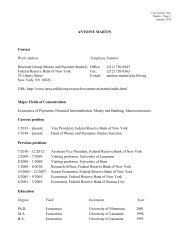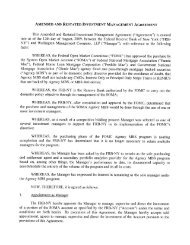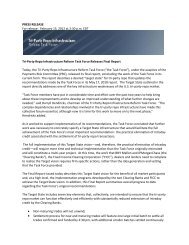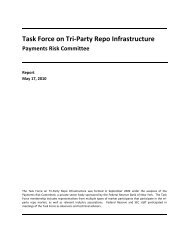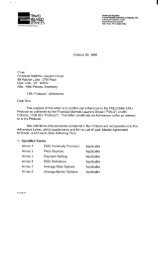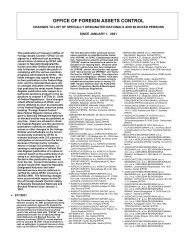Residential Foreclosures in the City of Buffalo, 1990-2000 - Federal ...
Residential Foreclosures in the City of Buffalo, 1990-2000 - Federal ...
Residential Foreclosures in the City of Buffalo, 1990-2000 - Federal ...
You also want an ePaper? Increase the reach of your titles
YUMPU automatically turns print PDFs into web optimized ePapers that Google loves.
would be imprudent to make any association between foreclosure rates and judgment-tovalue<br />
ratios; it is more important to note <strong>the</strong> similarity <strong>in</strong> <strong>the</strong>ir high values. It is useful,<br />
however, to exam<strong>in</strong>e <strong>the</strong> possible connection between judgment-to-value ratios and<br />
property rates.<br />
Communities with comparatively more decl<strong>in</strong>e <strong>in</strong> home prices might be expected<br />
to show higher judgment-to-value ratios at foreclosure. However, community judgmentto-value<br />
ratios do not correlate with <strong>the</strong> decl<strong>in</strong>e <strong>in</strong> property values found <strong>in</strong> our analysis<br />
and presented <strong>in</strong> Table 8. For example, West Side-Central demonstrated <strong>the</strong> most<br />
significant decl<strong>in</strong>e <strong>in</strong> home prices <strong>of</strong> <strong>Buffalo</strong> communities over <strong>the</strong> 1998-2002 period, 54<br />
percent, but its judgment-to-value ratio was <strong>the</strong> lowest among <strong>the</strong> communities. The<br />
circumstances <strong>in</strong> Ellicott-Masten were reversed, with <strong>the</strong> community demonstrat<strong>in</strong>g no<br />
drop <strong>in</strong> median home prices from 1998 to 2002, but a high judgment-to-value ratio <strong>in</strong><br />
<strong>2000</strong>. In some cases, <strong>the</strong> <strong>in</strong>consistency between home prices and judgment-to-value ratios<br />
may simply be due to tim<strong>in</strong>g; current assessed values used <strong>in</strong> this analysis are largely<br />
from <strong>2000</strong>, while <strong>the</strong> term<strong>in</strong>al year for <strong>the</strong> change <strong>in</strong> home prices is 2002. The disparity<br />
also suggests that <strong>the</strong> change <strong>in</strong> home values might differ between <strong>the</strong> houses be<strong>in</strong>g sold<br />
and <strong>the</strong> houses experienc<strong>in</strong>g foreclosure <strong>in</strong> <strong>the</strong>se communities.<br />
It would not be surpris<strong>in</strong>g to f<strong>in</strong>d current assessed values on foreclosed properties<br />
chang<strong>in</strong>g differently from home prices on recent sales. Due to <strong>the</strong> relatively large size <strong>of</strong><br />
<strong>the</strong> communities, it is likely that <strong>the</strong> behavior <strong>of</strong> <strong>the</strong> hous<strong>in</strong>g market varies with<strong>in</strong> <strong>the</strong>m.<br />
For <strong>in</strong>stance, <strong>the</strong> homes sell<strong>in</strong>g most <strong>in</strong> Ellicott-Masten over <strong>the</strong> 1998-2002 period are<br />
likely those built over <strong>the</strong> past decade. This may be why home prices <strong>in</strong> that community<br />
appear stable. However, <strong>the</strong> value <strong>of</strong> older homes is surely decl<strong>in</strong><strong>in</strong>g <strong>in</strong> some Ellicott-<br />
Masten neighborhoods, and such homes may represent a larger share <strong>of</strong> foreclosures than<br />
do new homes. In some cases, foreclosure itself may be responsible for a discrepancy<br />
between <strong>the</strong> values <strong>of</strong> foreclosed properties and those <strong>of</strong> recently sold homes. West Side-<br />
Central, for example, is see<strong>in</strong>g an <strong>in</strong>crease <strong>in</strong> sales accompanied by a large drop <strong>in</strong> home<br />
prices. This seems to <strong>in</strong>dicate an <strong>in</strong>crease <strong>in</strong> <strong>the</strong> share <strong>of</strong> lower-end homes on <strong>the</strong> market.<br />
Many <strong>of</strong> <strong>the</strong>se homes may <strong>in</strong> fact be recently foreclosed properties sell<strong>in</strong>g for barga<strong>in</strong><br />
prices. Thus, <strong>the</strong> assessed value <strong>of</strong> a foreclosed home may be higher than its distressed<br />
sale price after foreclosure.<br />
62



